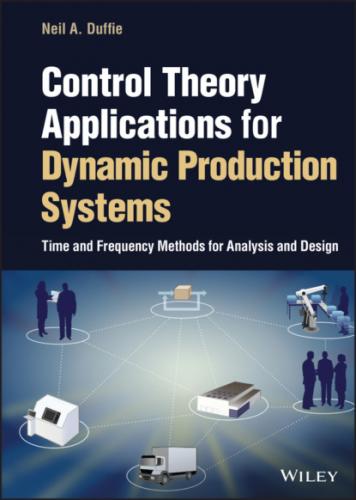The dynamic behavior represented by this continuous-time model is illustrated in Figure 2.2 for a case where there is a capacity disturbance rd(t) of –10 hours/day that starts at time t = 0 and lasts until t = 3 days. The initial WIP is ww(t) = 30 hours for t ≤ 0 days. The rate of work input is the same as the nominal production capacity, ri(t) = rp(t) hours/day, and there are no WIP disturbances: wd(t) = 0 hours. The response of WIP to the capacity disturbance is shown in Figure 2.2 and is calculated using Program 2.1 for 0 ≤ t ≤ 3 days using the known solution2
Figure 2.2 Response of WIP to 3-day capacity disturbance.
This model represents the production work system using the concept of work flows rather than representing the processing of individual orders. Numerous aspects of real work system operation are not represented such as setup times, operator skills and experience, reduction in actual capacity due to idle times when the work in progress is low, and physical limits on variables. Also, WIP cannot be negative and often cannot be greater than some maximum due to buffer size. Capacity cannot be negative and cannot be greater than some maximum that is determined by physical characteristics such as the number of workers, number of shifts, available equipment, and available product components or raw materials.
Program 2.1 WIP response calculated using solution of differential equation
ww0=30; % initial WIP (hours) rd0=-10; % capacity disturbance (hours/day) t(1)=-2; rd(1)=0; ww(1)=ww0; % initial values t(2)=0; rd(2)=rd0; ww(2)=ww(1); % disturbance starts t(3)=3; rd(3)=0; ww(3)=ww(2)-3*rd0; % solution of differential equation t(4)=6; rd(4)=0; ww(4)=ww(3); % disturbance ends stairs(t,rd); hold on % plot disturbance and WIP vs time - Figure 2.2 plot(t,ww); hold off xlabel('time t (days)') legend ('capacity disturbance r_d(t) (hours/day)','WIP w_w(t) (hours)')
Example 2.2 Continuous-Time Model of Backlog Regulation in the Presence of Rush Orders and Canceled Orders
A continuous-time model is needed for the production system illustrated in Figure 2.3 that would facilitate design of an order release rate adjustment decision rule that tends to maintain backlog at a planned level. This type of decision-making can be referred to as backlog regulation, and it could operate manually or automatically. There are fluctuations in order input rate and disturbances in the form of rush orders and canceled orders that must be responded to by adjusting the order release rate in a manner that tends to eliminate deviations of actual backlog from planned backlog.
Figure 2.3 Backlog regulation in the presence of rush orders and canceled orders.
There are two main components: accumulation of orders in the backlog, and order release rate decision-making. The differential equation that describes backlog is similar to that developed in Example 2.1:
where wb(t) orders is the order backlog, wd(t) orders represents disturbances such as rush orders and order cancelations, ri(t) orders/day is the order input rate, and ro(t) orders/day is the order release rate.
There are many possible decision rules that can be used to implement backlog regulation. One straightforward option is to adjust the order release rate ro(t) orders/day as a function of the both difference between planned backlog and actual backlog and the integral of that difference. This decision rule is described by
or
where wp(t) orders is the planned order backlog and K1 days−1 and K2 days−2 are backlog regulation decision parameters for which values are selected that result in favorable closed-loop backlog regulation dynamic behavior. Knowledge of order input rate ri(t) orders/day and work disturbances wd(t) orders is not required in this decision rule; instead, work disturbances and fluctuations in order input rate cause backlog wb(t) orders to increase or decrease, and deviations from planned backlog wp(t) orders subsequently are responded to using the decision rule.
Combining these component models to obtain a complete system model that relates backlog to the various inputs would be straightforward in this case, but this is easily and generically done using the transformation methods described in Chapter 3. Analysis using this combined model would allow selection of a combination of values of decision rule parameters K1 and K2 that satisfy requirements for dynamic behavior such as quick return of backlog to plan after a rush order or canceled order disturbance. Other options for the form of the decision rule could result in significantly different and possibly improved regulation of backlog.
Example 2.3 Continuous-Time Model of Mixture Temperature Regulation using a Heater
Experimental results can be used to obtain component models. Consider a portion of a production process in which it is necessary to deliver a mixture at a desired temperature. A heater at the outlet of a pipe is used to raise the temperature of the mixture flowing in the pipe to the desired level. Predicting the heater voltage required to deliver the mixture at the correct temperature is unlikely to be successful because of uncertainty in mixture inlet temperature. Therefore, as shown in Figure 2.4, a closed-loop temperature regulation approach is used in which a temperature sensor is placed at the end of the pipe and feedback from this sensor is used to adjust the heater voltage until the desired mixture temperature is obtained.
